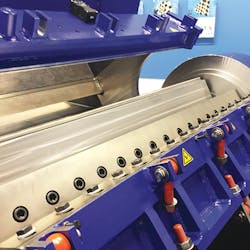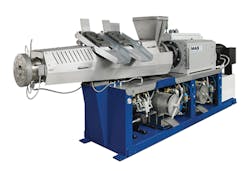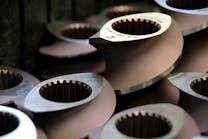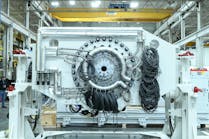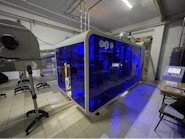Fakuma 2015, held in October, yielded several new technologies in recycling equipment. These technologies included a granulator with a unique one-piece rotor; an unusual screw conveyor system to feed material into granulators; and a twin-screw extruder that is gaining acceptance among recyclers who have traditionally favored single-screw extruders.
Here are those highlights and more:
HELLWEG
Hellweg Maschinenbau GmbH & Co. KG, Roetgen, Germany, expanded its Series 450 line of high-performance granulators with a model that can accommodate parts up to about 47 inches wide.
The 450mm diameter rotor is made from one piece of metal and weighs 1.65 tons. There are no welded parts.
"The heavy, one-piece rotor is more stable, so vibration is reduced," says Mark Hellweg, managing director of the company. Better stability means less dust and longer life for the knives.
"It also means we can use a smaller motor — only 45 kilowatts," he says. "This is probably half the size of what most granulators of this capacity use." Even with the smaller motor, torque is high. Rotor speed is 480 revolutions per minute.
The Series 450 can be configured with three to seven rotor knives. For lumps or thick-wall pipe, optional knife configurations are available. Two static knives are standard, but the number can be increased for higher throughput. Throughput ranges from 1,300 to 4,400 pounds per hour, depending on the configuration.
Hellweg said the granulator uses an aggressive double scissors helical cut. It is especially suited for thick parts, sheet, pipes and profiles.
Hellweg said the double scissors helical cutting action means it can cut everything, including foam, foil, EPS and even paper. "We are cutting, not crushing," he said. No suction is needed for any plastic material.
Both straight and slanted housing designs are available.
The company, which was started by Hellweg's father, has been building granulators since 1996.
HERBOLD
Herbold Meckesheim GmbH, Meckesheim, Germany, demonstrated its Herbold Plastcompactor HV 70, which compacts low bulk density plastic into agglomerate with higher bulk density.
The feed material that has already been through a shredder or granulator (up to about 0.4 inch, or 1 inch, depending on the type) is moved into a buffer silo, then fed continuously by an auger between a rotating and fixed compaction disc. Friction, which heats the material, is created on and between the disc. The material is then spun off and conveyed by a blower to a secondary granulator.
The size of the agglomerate is determined by the granulator screen. The material next passes through a sifting station where it is cooled and separated from fines.
The material stays in the compacting zone for just a few seconds, so thermal impact is minimal. Herbold says this is an advantage over extruders or conventional batch agglomerators. The end product is air-cooled agglomerate with good flow characteristics and high bulk density.
An automatic control system shows system performance and material temperature. It also stores recipes needed for different types of materials.
HV series Plastcompactors can agglomerate fibers, small tapes, foams, films, stretch or thin films, fine particles, powder and shavings. The process dries the material. Also, fillers or additives can be added during the heating process via dosing units mounted above the feed screw and before the compacting zone.
HV Plastcompactors are available in nine models, ranging from the HV 30/55, which has 300mm processing discs and a 55 kilowatt motor, to the HV 70/250, with 700mm discs and a 250 kw motor. Throughputs up to 3,300 pounds per hour are possible.
MAS
MAS Maschinen und Anlagenbau Schulz GmbH, Pucking, Austria, represented in North America by efactor3 LLC, Pineville, N.C., showed its upgraded conical co-rotating twin-screw extruder. It says the machine is gaining acceptance in the recycling industry.
The design features a large feed opening, especially suited for materials with a low bulk density and large intake volume. For example, film flakes can be fed in without being compressed first. Additives can be metered into the film flakes and fed into the extruder at the same time.
Since the intake volume is significantly greater than the discharge volume, the screw filling level is high.
Good feed behavior also means a short melt retention time in the extruder at low melt temperatures. MAS says its extruder is especially suited for recycling plastics that are sensitive to temperatures and shearing. It offers a gentle material treatment and stable melt pressure. Additionally, the extruder's homogeneous plastic melt lends itself to the melt filtration and degassing important to recyclers.
No melt pump is needed to produce pressure stabilization and buildup.
A large shaft diameter produces high torque at low energy consumption. The MAS conical co-rotating twin screw comes in five sizes, ranging from the MAS 45 with an output of 220 to 550 pounds per hour to the MAS 93 with output ranging from about 2,600 to 4,400 pounds per hour.
NEUE HERBOLD
Neue Herbold Maschinen und Anlagenbau GmbH, Sinsheim-Reihen, Germany, has developed a screw-conveyor system to force-feed material into its granulators.
The new system, especially suited for loose material such as PET bottles, increases throughput up to 30 percent, says sales manager Bernd Humpa.
Material fed into the hopper is moved to the grinding chamber by one or more vertical screws. The number of screws used depends on the granulator capacity. Rotor blockage is prevented by a transport screw equipped with a load-dependent control as well as a frequency converter.
Humpa says all kinds of plastic bottles, canisters, packing material and thin-wall, hollow containers work well with this feeding method.
The consistent material flow optimizes rotor capacity. Material fly-out from the feed hopper is reduced, which results in more complete processing of all the material. The consistent material flow also reduces noise.
Humpa says Wellman International Ltd. has been testing the new feed system at its facility in Verdun, France, and reports that throughput has increased as much as 25 percent and power peaks have been eliminated.
Neue Herbold also says that the constant feed results in longer life for the granulator. The tool life is unchanged despite the higher throughput.
The company offers a wide range of granulators with the force-feeding system.
Ron Shinn, editor
rshinn@plasticsmachinerymagazine.com
Contact:
eFactor3 LLC, 704-944-3232, www.efactor3.com
Hellweg Maschinenbau GmbH & Co. KG, 49 2471 4254, www.hellweg-granulators.com
Herbold Meckesheim USA, 401-597-5500, www.herboldusa.com
Neue Herbold Maschinen und Anlagenbau GmbH, 49 7261 9248 0, www.neue-herbold.com
Ron Shinn | Editor
Editor Ron Shinn is a co-founder of Plastics Machinery & Manufacturing and has been covering the plastics industry for more than 35 years. He leads the editorial team, directs coverage and sets the editorial calendar. He also writes features, including the Talking Points column and On the Factory Floor, and covers recycling and sustainability for PMM and Plastics Recycling.
